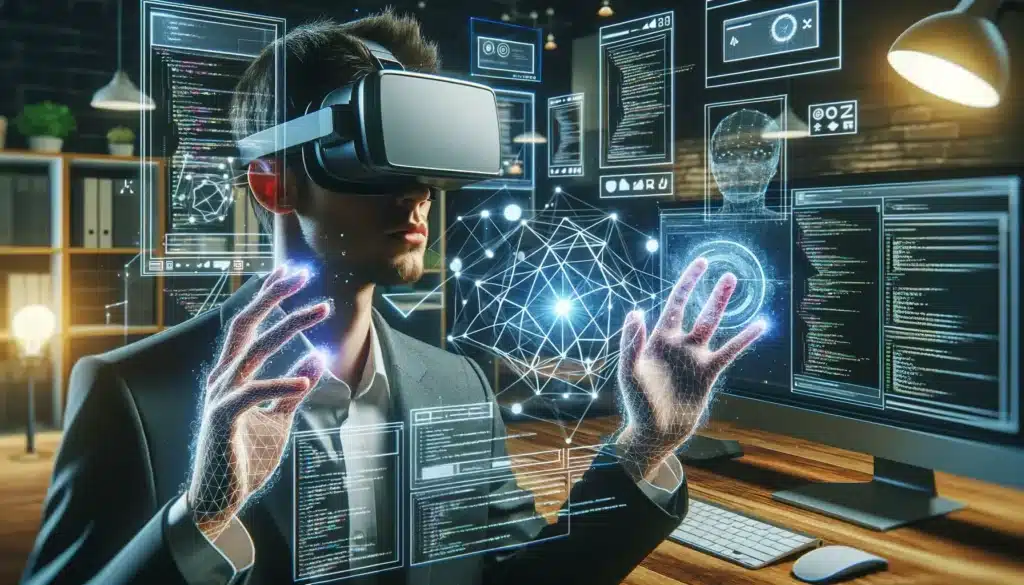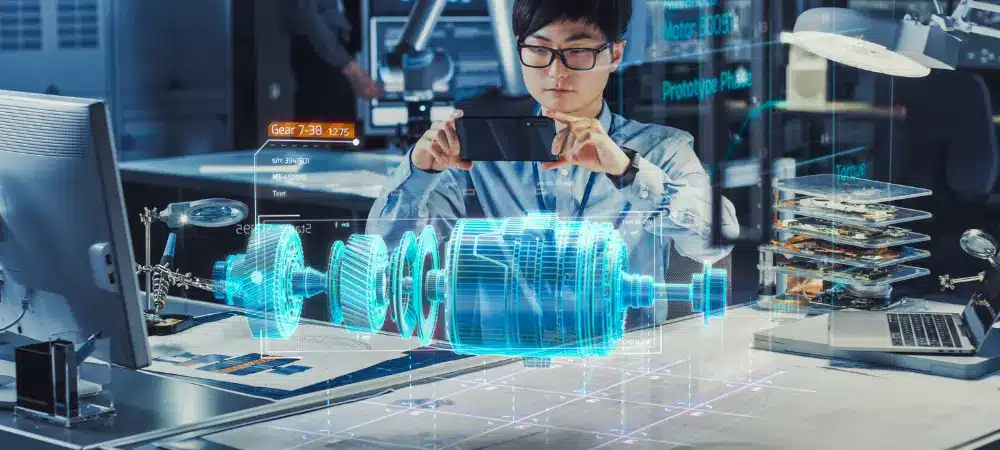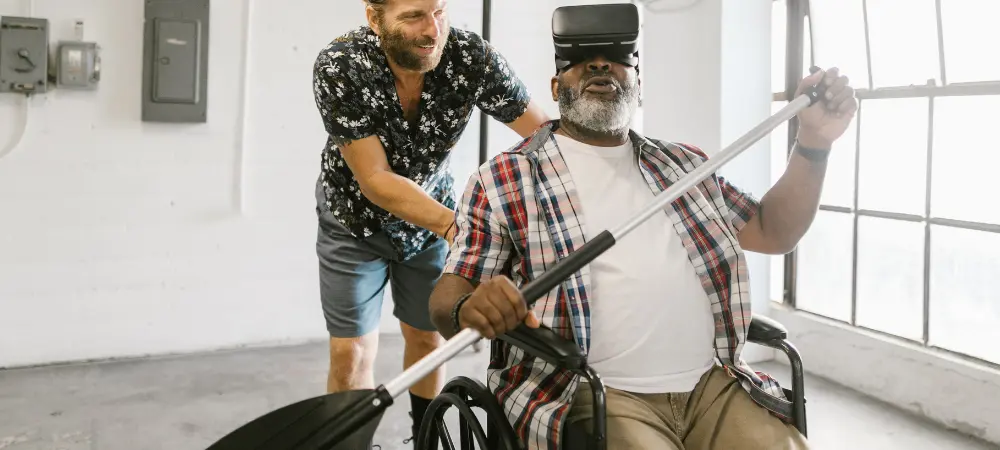In the ever-changing landscape of technology, Augmented Reality (AR) and Virtual Reality (VR) stand as transformative pillars in the world of web design.
Augmented Reality, or AR, involves the seamless integration of digital components into the real world, augmenting the user’s sensory experience.
On the flip side, Virtual Reality, or VR, engulfs users in entirely virtual environments, offering a complete departure from the physical world.
The importance of AR and VR becomes increasingly evident. These technologies transcend conventional boundaries, offering immersive and interactive experiences that captivate audiences. From heightened user engagement to the revolutionary delivery of content, AR and VR play a pivotal role in shaping the future of web design.
In this article, we discuss using AR and VR in web design.
Understanding AR and VR Technologies
AR vs. VR: Key Differences
Understanding the distinctions between Augmented Reality (AR) and Virtual Reality (VR) is essential for effective web design. Here, we break down the key differences that shape the unique contributions of AR and VR to the digital landscape:
- Nature of Interaction
- AR: Augments the real world by overlaying digital elements onto it.
- VR: Immerses users in entirely simulated environments, disconnecting them from the physical world.
- User Experience
- AR: Enhances the user’s sensory input with contextual information, graphics, or interactive content within their real-world environment.
- VR: Offers a fully immersive experience, creating a complete departure from reality and transporting users to digitally fabricated environments.
- Device Usage
- AR: Often experienced through smartphones, tablets, or AR glasses, utilizing the device’s camera for real-world interaction.
- VR: Requires dedicated hardware such as VR headsets, controllers, and sensory input devices for a comprehensive virtual experience.
- Context of Use
- AR: Well-suited for applications that enhance real-world experiences, provide contextual information, or enable interactive marketing.
- VR: Excelling in applications where complete immersion is desired, such as virtual tours, training simulations, and immersive storytelling.
- Level of Immersion
- AR: Provides a blended experience, enhancing the real world with digital overlays but maintaining a connection to the user’s immediate surroundings.
- VR: Creates a fully immersive and self-contained experience, allowing users to be completely engrossed in a digitally created environment.
- Use Cases in Web Design
- AR: Ideal for contextual information delivery, interactive marketing campaigns, and enhancing real-world interactions on web platforms.
- VR: Suited for applications demanding complete immersion, including virtual tours, product visualizations, and narrative-driven experiences on web platforms.

Core Technologies and Components
Augmented Reality (AR) Technologies
Augmented Reality, as a transformative force in web design, draws upon a rich tapestry of technologies that seamlessly merge the digital and physical realms.
- Marker-Based AR
- Utilizes visual cues, such as QR codes or predefined markers, to anchor digital overlays in the real world.
- Ideal for applications where specific triggers prompt augmented content, providing users with targeted and interactive experiences.
- Markerless AR
- Leverages advanced technologies like object recognition, GPS, and Simultaneous Localization and Mapping (SLAM) for a more context-aware augmentation.
- Offers a dynamic and adaptive AR experience by recognizing and responding to the surrounding environment, enabling fluid interaction with the user’s surroundings.
- Object Recognition
- Employs algorithms to identify and track real-world objects, allowing AR content to seamlessly integrate with and respond to the user’s environment.
- Enhances user engagement by providing contextually relevant information based on recognized objects.
- GPS Integration
- Utilizes Global Positioning System (GPS) data to geolocate users and deliver location-specific AR content.
- Ideal for location-based applications, such as augmented navigation or location-specific information delivery on web platforms.
- SLAM (Simultaneous Localization and Mapping)
- Combines data from sensors (like cameras and accelerometers) to map the user’s surroundings in real-time while simultaneously tracking their position.
- Enables a more immersive and accurate AR experience by dynamically adjusting digital content based on the user’s changing environment.
Virtual Reality (VR) Technologies
Virtual Reality, on the other hand, requires a distinctive set of technologies to craft entirely immersive digital environments.
- Head-Mounted Displays (HMDs)
- Core devices that users wear to view VR content, provide a visual gateway into the virtual world.
- Range from simple smartphone-based HMDs to sophisticated standalone and tethered devices that offer high-quality visuals and immersive experiences.
- Motion Controllers
- Handheld devices enable users to interact with the virtual environment, translating physical movements into digital actions.
- Enhance user engagement by allowing them to navigate, manipulate objects, and interact with the VR space.
- Spatial Tracking Systems
- Employ sensors and cameras to track the user’s movements in physical space, ensuring a seamless and accurate translation of their actions into the virtual world.
- Enhance the sense of presence by allowing users to explore and interact with the virtual environment naturally and intuitively.
Benefits of Integrating AR and VR in Web Design
Enhanced User Experience
Incorporating Augmented Reality (AR) and Virtual Reality (VR) into web design yields a plethora of benefits, foremost among them being the enhancement of user experiences. By seamlessly blending digital elements with the real world (AR) or immersing users in virtual realms (VR), web designers can create environments that transcend the conventional, providing users with a heightened sense of interaction and connectivity.
Increased Engagement and Interactivity
The integration of AR and VR elevates user engagement to unprecedented levels. AR facilitates interactive experiences by overlaying digital content onto the user’s physical surroundings, encouraging exploration and real-time interaction. On the other hand, VR immerses users in a simulated environment, where their actions dictate the narrative, resulting in a more profound and engaging interaction. The net result is a dynamic and participatory user experience that goes beyond the limitations of traditional web design.
Potential Business Applications
- E-commerce: AR enables users to visualize products in their real-world environment before making a purchase decision. For instance, a furniture retailer’s website could allow customers to see how a sofa looks in their living room using AR. On the other hand, VR facilitates immersive shopping experiences, where users can virtually explore a store, examine products, and make informed choices, creating a more personalized and enjoyable shopping journey.
- Education: AR transforms educational content by overlaying supplemental information onto textbooks or physical objects, enhancing the learning experience. This can be particularly impactful in subjects like biology or history, where three-dimensional models can come to life. On the other hand, VR offers virtual field trips, simulations, and interactive learning environments, transporting students to places or scenarios that may be impractical or impossible to experience in the physical world.
- Entertainment: AR enhances entertainment experiences by providing interactive overlays during live events or performances. For instance, AR applications during a concert might display real-time lyrics or information about the artists. On the other hand, VR offers immersive storytelling experiences, interactive gaming environments, and virtual events, creating a sense of presence and engagement that traditional media cannot match.

Challenges and Considerations
The integration of Augmented Reality (AR) and Virtual Reality (VR) in web design brings forth a spectrum of challenges and considerations that demand careful attention. Navigating these hurdles is crucial for delivering seamless and responsible experiences. Let’s delve into the key challenges and considerations.
Technical Challenges
The adoption of AR and VR in web design introduces a set of technical hurdles that designers and developers must navigate. These challenges include:
- Device Compatibility: Ensuring that AR and VR experiences are accessible across a diverse range of devices presents a significant challenge. Compatibility issues may arise due to variations in hardware capabilities and software standards.
- Performance Optimization: Achieving optimal performance is essential for a smooth and immersive user experience. Balancing high-quality visuals with efficient resource utilization requires meticulous optimization, especially in resource-intensive VR applications.
- Integration with Existing Technologies: Seamlessly integrating AR and VR functionalities with existing web technologies can be complex. Compatibility with content management systems, databases, and other web infrastructure components poses integration challenges.
User Experience Challenges
Delivering a positive user experience is paramount when integrating AR and VR into web design. Addressing the following challenges is crucial for ensuring user satisfaction:
- Motion Sickness: VR experiences, in particular, can induce motion sickness in users. Designing interfaces and interactions that minimize discomfort is a persistent challenge in creating enjoyable and nausea-free experiences.
- User Interface Design: Crafting intuitive and user-friendly interfaces in the immersive environments of AR and VR demands a departure from traditional design principles. Navigating spatial design challenges and ensuring ease of use is an ongoing consideration.
- Content Relevance: Striking a balance between augmented content and the user’s real-world context in AR, and maintaining engagement without overwhelming users with information, poses a nuanced challenge.
Ethical and Privacy Considerations
The integration of AR and VR technologies introduces ethical and privacy considerations that must be carefully addressed:
- User Data Protection: Collecting and processing user data in AR and VR experiences raises privacy concerns. Ensuring robust data protection measures, transparent privacy policies, and obtaining informed consent become critical elements of responsible design.
- Real-world Impact: AR, especially, has the potential to impact real-world experiences. Striking a balance between enhancing reality and preserving authenticity is crucial to avoid unintended consequences or misinformation.
- Accessibility and Inclusivity: Ensuring that AR and VR experiences are accessible to users with diverse abilities is an ethical imperative. Designing with inclusivity in mind involves addressing challenges related to user interfaces, sensory experiences, and content accessibility.
Implementing AR and VR in Web Design
As the integration of Augmented Reality (AR) and Virtual Reality (VR) becomes increasingly prevalent in web design, the successful implementation of these immersive technologies requires a strategic approach.
Design Principles for AR and VR
- User-Centered Design: Prioritize the user experience by understanding the needs, behaviors, and preferences of your target audience. Design interfaces and interactions that are intuitive, responsive, and enhance user engagement.
- Spatial Awareness: Leverage the spatial dimensions of AR and VR environments. Consider how digital elements interact with physical space in AR or how users navigate and interact within the virtual space in VR. Spatial awareness enhances the sense of immersion.
- Consistent Visual Language: Maintain a consistent visual language throughout AR and VR experiences. Consistency in design elements, color schemes, and typography contributes to a cohesive and branded user experience.
- Feedback and Affordances: Provide clear feedback and affordances to guide users through AR and VR interactions. Visual cues, audio feedback, and haptic responses contribute to a more intuitive and responsive experience.
Best Practices in Development
- Optimization for Performance: Prioritize performance optimization to ensure smooth and responsive experiences. Efficiently manage resources, reduce latency, and optimize graphics to deliver high-quality AR and VR content without compromising performance.
- Cross-Platform Compatibility: Develop AR and VR applications with cross-platform compatibility in mind. Consider the diverse range of devices, operating systems, and browsers to maximize accessibility and reach a broader audience.
- Progressive Enhancement: Implement a progressive enhancement strategy, allowing AR and VR features to gracefully degrade on devices or browsers that may not support these technologies fully. This ensures a baseline user experience across all platforms.
- Iterative Testing: Conduct iterative testing throughout the development process. Regularly test AR and VR experiences on different devices to identify and address any issues related to performance, user interface, or compatibility.
Tools and Platforms for Implementation
- AR Development Tools
- ARKit (iOS) and ARCore (Android): These platforms provide comprehensive toolsets for creating AR applications on mobile devices, offering features like motion tracking and environmental understanding.
- WebAR: Explore emerging technologies like WebAR, enabling AR experiences directly through web browsers without the need for additional applications.
- VR Development Tools
- Unity and Unreal Engine: Widely used game development engines that support VR development. They provide a range of features for creating immersive VR environments and interactions.
- A-Frame and Three.js: Web-based frameworks that simplify VR development, allowing for the creation of VR experiences directly within web browsers.
- Cross-Platform Integration
- WebXR: An API that facilitates the development of immersive experiences for the web, supporting both AR and VR. It enables cross-platform compatibility and seamless integration across devices.
- Mozilla Hubs: A platform for creating social VR experiences accessible through web browsers, emphasizing collaborative virtual spaces.

Conclusion
The adoption of AR and VR in web design requires a focus on education, user-centric approaches, and cross-disciplinary collaboration. By equipping professionals, prioritizing user experiences, and fostering teamwork, the seamless integration of these technologies becomes more attainable.
The future of AR and VR in web design promises enhanced accessibility, innovative design practices, and integration with emerging technologies. These advancements open avenues for designers to create visually stunning, immersive, and interconnected digital experiences that redefine the landscape of online interaction.
In essence, AR and VR represent not just technologies but gateways to a new era in web design.
Why Clio Websites
We hope that we helped you to understand using AR and VR in web design. Our recommendations and techniques are based on years of experience helping businesses like yours.
At Clio, we have helped many clients grow their businesses with websites tuned for engagement and conversions.
Contact us if you would like us to help you create a unique website that your visitor will love.



